The Private Tutoring Market is estimated to be valued at USD 70.4 billion in 2025 and is projected to reach USD 171.3 billion by 2035, registering a compound annual growth rate (CAGR) of 9.3% over the forecast period.
The Private Tutoring market is experiencing strong growth, driven by the increasing demand for personalized and flexible learning solutions across academic levels. Rising parental focus on student performance, competitive examinations, and skill development has fueled the adoption of private tutoring services. Technological advancements in digital learning platforms, interactive content, and virtual classrooms have enabled scalable online learning solutions, allowing students to access expert guidance from any location.
Integration of AI-driven learning analytics, adaptive assessments, and real-time feedback mechanisms has further enhanced the effectiveness and engagement of tutoring programs. The market is also being supported by the growth of hybrid models that combine online and offline tutoring, catering to diverse learning preferences.
Increasing awareness of the benefits of individualized attention, coupled with the expansion of K-12 educational institutions and exam preparation demand, is shaping market dynamics As parents and institutions continue to prioritize student outcomes, private tutoring is expected to maintain sustained growth, with innovations in digital delivery and personalized instruction creating significant opportunities in both developed and emerging markets.
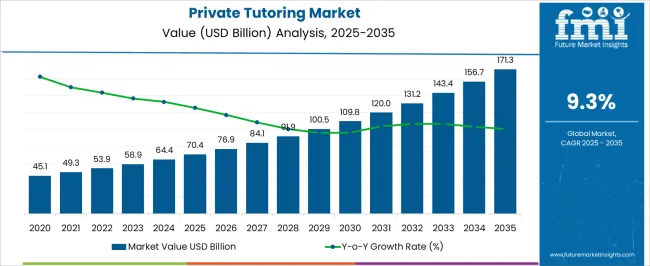
| Metric | Value |
|---|---|
| Private Tutoring Market Estimated Value in (2025 E) | USD 70.4 billion |
| Private Tutoring Market Forecast Value in (2035 F) | USD 171.3 billion |
| Forecast CAGR (2025 to 2035) | 9.3% |
The market is segmented by Mode, Application, Subject, Duration, and Tutoring Style and region. By Mode, the market is divided into Online and Offline. In terms of Application, the market is classified into Up-To K-12 and Post K-12. Based on Subject, the market is segmented into Academic and Non-Academic. By Duration, the market is divided into Short-Term Courses and Long-Term Courses. By Tutoring Style, the market is segmented into Subject Tutoring Service and Test Preparation Service. Regionally, the market is classified into North America, Latin America, Western Europe, Eastern Europe, Balkan & Baltic Countries, Russia & Belarus, Central Asia, East Asia, South Asia & Pacific, and the Middle East & Africa.
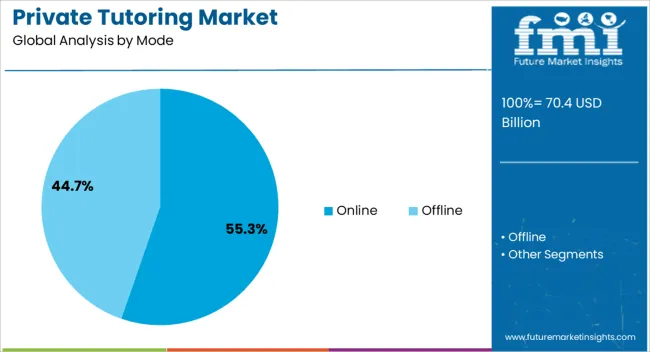
The online mode segment is projected to hold 55.3% of the market revenue in 2025, establishing it as the leading mode of private tutoring. Growth in this segment is being driven by the convenience and flexibility offered to students, allowing access to quality instruction without geographical limitations. Online tutoring platforms enable interactive learning through video lectures, live sessions, and AI-powered assessments, enhancing engagement and knowledge retention.
Integration with adaptive learning technologies and learning management systems allows for personalized lesson plans and real-time performance tracking. The segment has further benefited from the proliferation of internet access, mobile devices, and digital content libraries, which facilitate widespread adoption.
Cost efficiency and time savings for both tutors and students reinforce the preference for online delivery With the increasing focus on remote learning and digital education solutions, the online mode is expected to maintain its market leadership, driven by technological innovation, scalability, and the ability to meet evolving student learning needs across diverse educational contexts.
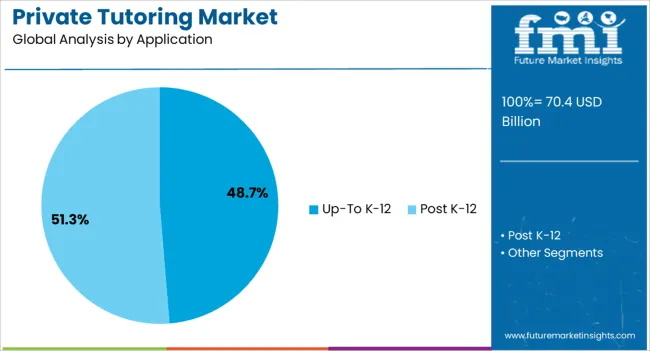
The Up-To K-12 application segment is anticipated to account for 48.7% of the market revenue in 2025, making it the leading application area. Growth in this segment is being supported by increasing demand for academic support in foundational subjects, exam preparation, and skill enhancement for school-aged students. Private tutoring enables individualized attention and tailored learning strategies, which help students improve performance and build confidence.
The integration of digital tools and online platforms allows tutors to monitor progress, provide personalized feedback, and address learning gaps efficiently. Rising parental awareness, competitive schooling environments, and the emphasis on early academic achievement further reinforce adoption.
Educational institutions and tutoring centers are increasingly offering structured K-12 programs, blending traditional teaching with technology-enabled solutions As education systems continue to prioritize student outcomes and holistic learning, the Up-To K-12 segment is expected to remain the primary driver of private tutoring demand, supported by both online and hybrid learning models that enhance accessibility and effectiveness.
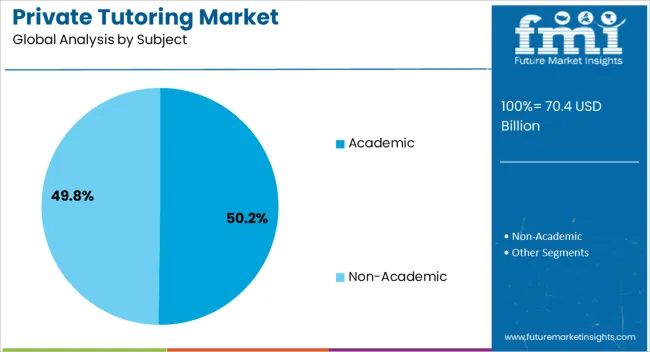
The academic subject segment is projected to hold 50.2% of the market revenue in 2025, establishing it as the leading subject category. Growth is driven by the sustained demand for tutoring in core subjects such as mathematics, science, and languages, which are considered essential for academic performance and examination success. Private tutoring in academic subjects provides structured, personalized instruction that targets specific learning needs and knowledge gaps.
The use of interactive digital content, AI-based assessments, and real-time progress tracking enhances learning outcomes and engagement. Parents and students increasingly prefer academic-focused tutoring to improve grades, prepare for competitive examinations, and build foundational knowledge.
Rising competition in school curricula and standardized testing further fuels the adoption of academic tutoring services As educational institutions and families continue to prioritize measurable learning outcomes, the academic subject segment is expected to maintain its leading position, supported by tailored content, personalized instruction, and integration with online learning platforms that maximize effectiveness and accessibility.
Reforming Education System and Technological Developments
Adoption of private tutoring surges due to changes in the education system all over the world. Several countries are reforming their education system by changing educational infrastructure and academics. By implementing a more competitive and examination-oriented education system, market players are offering additional support for students for a better understanding of their studies.
Integration of the latest technological advancements is proving fruitful for the market. Private tutors started providing digital tutorial platforms to students for a better understanding. Private tutoring companies have gained more potential in recent years by integrating artificial intelligence (AI) into educational studies.
Increased Competition and Income
In every field, increased competition can be observed, and private tutoring is no exception. Competition in admissions in reputed universities and jobs is driving the demand for private tutoring. Their students are looking for ways to sustain themselves in the competition by appointing private tutors for their studies and educational purposes.
The surge in Income of the middle-class segment is providing benefits to the market in the current period. Higher Income has made private tutoring more affordable to people in recent years. Social media culture is on the rise, where people are seeking new learnings. Thus, private tutoring is gaining popularity in the sector.
| Attributes | Details |
|---|---|
| Mode of Transportation | Offline |
| Market CAGR from 2025 to 2035 | 9.1% |
Need for personalized and targeted education is anticipated to optimize the outlook of this segment during the forecast period. The offline segment has gained popularity over the years by offering one-to-one interaction and a more personalized learning experience. However, a rise in focused and targeted learning environments is leading the segment's growth. Students can learn without any disturbance in the online environment.
| Attributes | Details |
|---|---|
| Product Type | Academic |
| Market CAGR from 2025 to 2035 | 8.9% |
The changing structure of the education system and increasing competition among students in academics leads to the growth of the segment. In recent years, students have been getting support from private tutors for a better understanding of their studies. Also, private tutoring services have been seen as providing a greater understanding of the syllabus and studies over the school and colleges; thus, students prefer private tutoring for their academic purposes.
| Countries | CAGR from 2025 to 2035 |
|---|---|
| United States | 9.6% |
| China | 9.9% |
| United Kingdom | 10.3% |
| Japan | 10.9% |
| South Korea | 11.1% |
The United States is one of the most technologically advanced region in the world. The government of the United States is actively spending on its education infrastructure.
The government collaborates with schools, colleges, and other educational institutes to improve the condition of education. Also, private tutoring companies are leveraging the benefits, by building partnerships and collaborations with government educational schemes and others. Parents are increasingly investing in their student education to support their children.
Families that have higher incomes frequently spending more on their children's education in the United States. These families are increasingly able to give special facilities to their children such as appointing private tutors, home-based educational facilities, and others. For instance, Chegg Inc., a United States-based Edtech company launched a new feature called Learn with Chegg. It provides customized learning options to students integrating with AI support.
Private tutoring companies in China are heavily investing in research and development activities. They are launching new features and software that prioritize student convenience. Also, the modern lifestyle is making a huge contribution to the market share in the current period. Parents are aware of the benefits of providing a smart education system to their children. Private tutoring companies are offering more facilities than public institutes in China.
Online private tutoring is gaining popularity in the country, providing students with many facilities on their own devices or wherever they are. However, despite these benefits providing a solid structure to the education system, there are also concerns restraining market growth in the country, such as high costs of this system, stringent government policies, and others.
Private tutoring trends in the United Kingdom have been increasing in recent years. Students are rigorously opting for home tuition more than public tuition such as college or school. Private tutoring companies are expanding their facilities in the United Kingdom.
Ethnic background is contributing to market growth in the United Kingdom. According to the report, students of Asian ethnicities have received home tuition at some point in recent years in the United Kingdom, which is higher than the overall national average of 25%.
Competition in academics has rapidly increased in Japan. Securing admission to reputable universities is seen as a challenging aspect in the country. Thus the demand for private tutoring institutes has increased in recent years in the country. Parents are seeking better educational facilities for their children in the country.
The educational reform has played a major role in the growth of the market in South Korea. With the introduction of the new curriculum and several changes in the examinations thus, parents and students are seeking additional support for their studies. This is encouraging the private tutoring market growth in Japan.
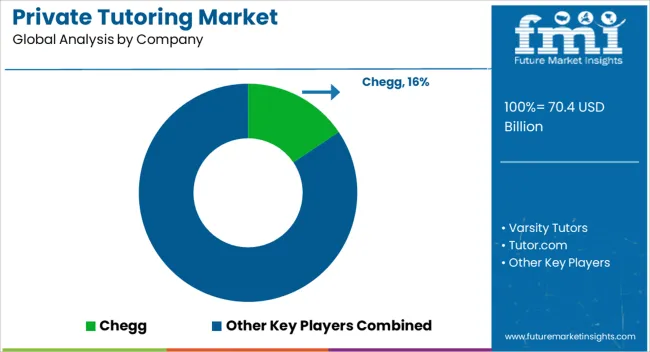
Private tutoring companies are looking to improve consumer experience by implementing new marketing strategies in the current period. The market is anticipated to experience exponential growth during the forecast period owing to innovations and research. Key players are investing in their educational infrastructure and services to gain maximum market share. Many governments are collaborating with private tutoring institutions to provide better facilities to their citizens.
Partnerships and Collaborations
In 2025, Chegg Inc. expanded its offerings by acquiring Mathway, a platform that specializes in solving mathematical problems. Its latest acquisition of Mathway, a popular mathematics-focused problem-solving platform, expands its reach in the STEM field. Mathway has been helping students solve complex math problems for over a decade, and its acquisition by Chegg is expected to provide students with an even wider range of resources to improve their academic performance.
Recent Developments
The global private tutoring market is estimated to be valued at USD 70.4 billion in 2025.
The market size for the private tutoring market is projected to reach USD 171.3 billion by 2035.
The private tutoring market is expected to grow at a 9.3% CAGR between 2025 and 2035.
The key product types in private tutoring market are online and offline.
In terms of application, up-to k-12 segment to command 48.7% share in the private tutoring market in 2025.






Our Research Products

The "Full Research Suite" delivers actionable market intel, deep dives on markets or technologies, so clients act faster, cut risk, and unlock growth.

The Leaderboard benchmarks and ranks top vendors, classifying them as Established Leaders, Leading Challengers, or Disruptors & Challengers.

Locates where complements amplify value and substitutes erode it, forecasting net impact by horizon

We deliver granular, decision-grade intel: market sizing, 5-year forecasts, pricing, adoption, usage, revenue, and operational KPIs—plus competitor tracking, regulation, and value chains—across 60 countries broadly.

Spot the shifts before they hit your P&L. We track inflection points, adoption curves, pricing moves, and ecosystem plays to show where demand is heading, why it is changing, and what to do next across high-growth markets and disruptive tech

Real-time reads of user behavior. We track shifting priorities, perceptions of today’s and next-gen services, and provider experience, then pace how fast tech moves from trial to adoption, blending buyer, consumer, and channel inputs with social signals (#WhySwitch, #UX).

Partner with our analyst team to build a custom report designed around your business priorities. From analysing market trends to assessing competitors or crafting bespoke datasets, we tailor insights to your needs.
Supplier Intelligence
Discovery & Profiling
Capacity & Footprint
Performance & Risk
Compliance & Governance
Commercial Readiness
Who Supplies Whom
Scorecards & Shortlists
Playbooks & Docs
Category Intelligence
Definition & Scope
Demand & Use Cases
Cost Drivers
Market Structure
Supply Chain Map
Trade & Policy
Operating Norms
Deliverables
Buyer Intelligence
Account Basics
Spend & Scope
Procurement Model
Vendor Requirements
Terms & Policies
Entry Strategy
Pain Points & Triggers
Outputs
Pricing Analysis
Benchmarks
Trends
Should-Cost
Indexation
Landed Cost
Commercial Terms
Deliverables
Brand Analysis
Positioning & Value Prop
Share & Presence
Customer Evidence
Go-to-Market
Digital & Reputation
Compliance & Trust
KPIs & Gaps
Outputs
Full Research Suite comprises of:
Market outlook & trends analysis
Interviews & case studies
Strategic recommendations
Vendor profiles & capabilities analysis
5-year forecasts
8 regions and 60+ country-level data splits
Market segment data splits
12 months of continuous data updates
DELIVERED AS:
PDF EXCEL ONLINE
Private Wealth Management Service Market Size and Share Forecast Outlook 2025 to 2035
Private Security Market Size and Share Forecast Outlook 2025 to 2035
Private Label Pet Food Market Size and Share Forecast Outlook 2025 to 2035
Private Electric Vehicle Charging Station Market Size and Share Forecast Outlook 2025 to 2035
Private 5G Network Market Size and Share Forecast Outlook 2025 to 2035
Private office-based clinics Market Size and Share Forecast Outlook 2025 to 2035
Private LTE Market Size and Share Forecast Outlook 2025 to 2035
Private Cloud Services Market by Services, Type, Industry Vertical, and Region – Growth, Trends, and Forecast through 2025 to 2035
AI Tutoring Services Market Analysis Size and Share Forecast Outlook 2025 to 2035
Virtual Private Cloud Market Size and Share Forecast Outlook 2025 to 2035
Virtual Private Network VPN Market Size and Share Forecast Outlook 2025 to 2035
Virtual Private Server Market Size and Share Forecast Outlook 2025 to 2035
5G Enterprise Private Network Market Size and Share Forecast Outlook 2025 to 2035
Demand for Hybrid Protein Blends in Private Label Formulations in CIS Size and Share Forecast Outlook 2025 to 2035

Thank you!
You will receive an email from our Business Development Manager. Please be sure to check your SPAM/JUNK folder too.
Chat With
MaRIA